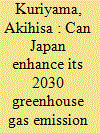| Srl | Item |
| 1 |
ID:
168337


|
|
|
|
|
| Summary/Abstract |
This study investigates the stringency of Japan's greenhouse gas emissions reduction target for 2030 (nationally determined contribution: NDC), focusing on the macroeconomic assumptions of Kaya indicators and others previously overlooked, e.g. GDP per working-age population. It also conducts a decomposition analysis in light of historic political and economic events.
We find that the real GDP growth assumption underlying the NDC target is unrealistic. Namely, the real GDP per working-age population, which is an indicator of productivity, needs to be improved annually by 2.5% on average for 15 years, a high level that has not been observed since the collapse of the economic bubble in the early 1990s.
|
|
|
|
|
|
|
|
|
|
|
|
|
|
|
|
| 2 |
ID:
150390


|
|
|
|
|
| Summary/Abstract |
Within the general context of Greenhouse Gas (GHG) emissions reduction, decomposition analysis allows the quantification of the contribution of different factors to changes in emissions as well as the assessment of the effectiveness of policy and technology measures. The Kaya identity has been widely used for that purpose in order to disaggregate carbon emissions into various driving forces. In this paper, it is applied for the analysis of emissions resulting from energy use at three different scales. First, a decomposition analysis of the carbon emissions for the complete Swiss energy system is presented using the future projections from the Swiss Energy Strategy 2050. The Kaya identity is then applied to the Swiss building sector after it is adapted with factors that are more relatable to building parameters, such as floor area instead of Gross Domestic Product (GDP). Finally, the last level of analysis is a small scale community energy system for a unique Swiss village that aims to significantly reduce its emissions. An energy strategy is developed and its effectiveness is assessed with the adapted Kaya identity and benchmarked against the Swiss average values. The presented method demonstrates how the performance of buildings under various retrofitting scenarios can be benchmarked against future emission targets.
|
|
|
|
|
|
|
|
|
|
|
|
|
|
|
|